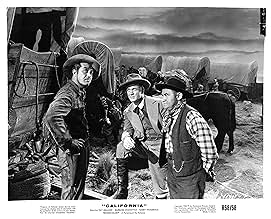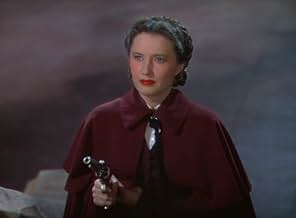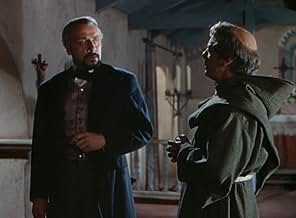CALIFICACIÓN DE IMDb
6.1/10
1.2 k
TU CALIFICACIÓN
Un desertor militar guía a Lily, Michael Fabian y otros colonos al Oeste hacia California durante la fiebre del oro, movidos por anhelos de aventura y riqueza.Un desertor militar guía a Lily, Michael Fabian y otros colonos al Oeste hacia California durante la fiebre del oro, movidos por anhelos de aventura y riqueza.Un desertor militar guía a Lily, Michael Fabian y otros colonos al Oeste hacia California durante la fiebre del oro, movidos por anhelos de aventura y riqueza.
John Alban
- Delegate
- (sin créditos)
George Anderson
- Miner
- (sin créditos)
Carl Andre
- Wagon Train Member
- (sin créditos)
Billy Andrews
- Boy
- (sin créditos)
Argumento
¿Sabías que…?
- TriviaThis film was in production November 1945-February 1946, and bears a 1946 copyright statement, and was released in January 1947.
- ErroresA number of the pistols used by characters appear to be cartridge revolvers, rather than cap-and-ball.
- Citas
Booth Pennock: You know, Trumbo, if ever you grow up, you'll learn that a woman is like a poker game. What you take in one hand you drop in the next.
- ConexionesFeatured in El poder del amor (1995)
Opinión destacada
This is a case where I feel like other reviewers have watched a different movie called "California" than the one I saw. The picture I enjoyed was a top-notch "A" western with an excellent cast, gorgeous Technicolor cinematography, spectacular California scenery, lively action, good pacing, and an intelligent, adult story.
At the top of the cast Ray Milland, Barbara Stanwyck, and Barry Fitzgerald, were at the peak of their careers. All three had garnered Academy Award honors within the past few years before "California's" early 1947 release. Milland was coming off his best actor award for Lost Weekend (1945), while Fitzgerald won best supporting actor for Going My Way (1944) and also got a best actor nomination for the same role! Stanwyck, a perennial bridesmaid of the Academy had received best actress nominations for Ball Of Fire (1941) and Double Indemnity (1944). "California" is a good showcase for their talents, each doing what he or she did best -- Ray the mild-mannered but hard-edged tough guy, Barry the lovable Irishman, and Barbara the hard broad who may or may not be hiding a heart of gold. Good support and stalwart villainy is provided by George Coulouris and Albert Dekker with a large cast of other supporting players and extras.
Some people can't picture Ray Milland as an appropriate western lead because of his British accent, even though it had became slight by the late 1940's when he had be living in the United States for two decades. But lots of people in the West would have had British and other foreign accents. Remember, we were and still are a nation of immigrants. Besides which Ray was imminently qualified to play westerns by his real life experiences. Having served several years in a crack British cavalry regiment in the 1920's, he was an expert horseman, and it shows by the way he sits a steed in "California". And he certainly knew which end of a gun the bullets came out of. A crack marksman, he helped his regiment win several prestigious shooting matches in his army days. Interestingly, he actually plays a professional trick shot artist in another western, Copper Canyon (see my review).
John Farrow's usual efficient direction and Eda Waren's editing keep the story moving along at a sharp pace. The script by Frank Butler and Theodore Strauss provides an intelligent, adult story with literate dialog. It gives an accurate, compelling picture of the California gold rush and the gold fever gripping immigrants to the Pacific Coast, as well as the movement for California statehood, a plot by the baddies for an armed overthrow of the government, and a torrid love triangle. As the intense, dark melodramas now known as film noir were at the height of their popularity when this western was filmed, the script endows the principles of the love triangle, Milland, Stanwyck, and Coulouris, with shady pasts. Milland's character, it turns out has deserted the Army. Stanwyck has been thrown out of every town she ever parked in for being -- shall we say charitably -- a floozy. Coulouris, villain enough as it is, has an even darker past as a slave ship captain. And he is now going slowly off his nut remembering the cries of the chained slaves and his fears they would rise up and get him. Dekker, occasionally a leading man or second lead, but more often a polished villain, is wasted here as Coulouris's former first mate and brutish henchman. Since Coulouris is always a bit over the top, perhaps "California" would have been better served if Dekker had had his role.
The script and Farrow's direction gives us just the right blend of dramatics and action. A rousing, old-time, full-bodied score by Victor Young helps move it along. Unlike other reviewers, I found the frequent outbursts of singing by both on-screen characters and an unseen chorus an asset to the picture, adding life and color and even historical accuracy. Some in this history challenged generation may not realize that in the days before people had television, computers, radio, movies, or even phonographs, they had to entertain themselves. They sang all the time, walking down the street, in their yards, in barber shops, at socials, around campfires (as in "California"), and in saloons. Even the meanest of saloons could usually scratch up some kind of band.
The costumes, sets, firearms, gun leather, lamps and other accouterments in "Callifornia" show an unusual degree of historical accuracy for a western of this era. No one has a repeating rifle, all muzzle loaders or crude breech loaders. Cap and ball revolvers are used in the closeups at least -- never mind they were not the exact models for 1849. You other gun nuts: in how many other movies have you seen a Hall breech loader? Good effort in this department.
Ray Rennahan, who did the camera work, gets credit for the unusually fine color cinematography, but with Natalie Kalmus on board as the Techniclor consultant, superb color was insured. The Technicolor Corporation required a consultant on every movie using their patented process, and Mrs. Kalmus, ex-wife of the inventor of Technicolor, was usually it. She was known around the studios as a bossy, irritating old dame, who interfered in set designs, camera set-ups, costume color and materials, prop selection, and virtually every other aspect of a color filming. She must, nevertheless, have known what she was doing. Every picture with her name on it will have muted, perfectly co-ordinated, precisely lighted, and generally superior color. After all, the studio technicians of the 1940's, as skilled as they were in black and white filming, had little experience with color. They actually needed a Natilie Kalmus, like it or not.
"California" in an A-1 Technicolor western, a visual treat and smooth, exciting entertainment from Hollywood's finest era.
At the top of the cast Ray Milland, Barbara Stanwyck, and Barry Fitzgerald, were at the peak of their careers. All three had garnered Academy Award honors within the past few years before "California's" early 1947 release. Milland was coming off his best actor award for Lost Weekend (1945), while Fitzgerald won best supporting actor for Going My Way (1944) and also got a best actor nomination for the same role! Stanwyck, a perennial bridesmaid of the Academy had received best actress nominations for Ball Of Fire (1941) and Double Indemnity (1944). "California" is a good showcase for their talents, each doing what he or she did best -- Ray the mild-mannered but hard-edged tough guy, Barry the lovable Irishman, and Barbara the hard broad who may or may not be hiding a heart of gold. Good support and stalwart villainy is provided by George Coulouris and Albert Dekker with a large cast of other supporting players and extras.
Some people can't picture Ray Milland as an appropriate western lead because of his British accent, even though it had became slight by the late 1940's when he had be living in the United States for two decades. But lots of people in the West would have had British and other foreign accents. Remember, we were and still are a nation of immigrants. Besides which Ray was imminently qualified to play westerns by his real life experiences. Having served several years in a crack British cavalry regiment in the 1920's, he was an expert horseman, and it shows by the way he sits a steed in "California". And he certainly knew which end of a gun the bullets came out of. A crack marksman, he helped his regiment win several prestigious shooting matches in his army days. Interestingly, he actually plays a professional trick shot artist in another western, Copper Canyon (see my review).
John Farrow's usual efficient direction and Eda Waren's editing keep the story moving along at a sharp pace. The script by Frank Butler and Theodore Strauss provides an intelligent, adult story with literate dialog. It gives an accurate, compelling picture of the California gold rush and the gold fever gripping immigrants to the Pacific Coast, as well as the movement for California statehood, a plot by the baddies for an armed overthrow of the government, and a torrid love triangle. As the intense, dark melodramas now known as film noir were at the height of their popularity when this western was filmed, the script endows the principles of the love triangle, Milland, Stanwyck, and Coulouris, with shady pasts. Milland's character, it turns out has deserted the Army. Stanwyck has been thrown out of every town she ever parked in for being -- shall we say charitably -- a floozy. Coulouris, villain enough as it is, has an even darker past as a slave ship captain. And he is now going slowly off his nut remembering the cries of the chained slaves and his fears they would rise up and get him. Dekker, occasionally a leading man or second lead, but more often a polished villain, is wasted here as Coulouris's former first mate and brutish henchman. Since Coulouris is always a bit over the top, perhaps "California" would have been better served if Dekker had had his role.
The script and Farrow's direction gives us just the right blend of dramatics and action. A rousing, old-time, full-bodied score by Victor Young helps move it along. Unlike other reviewers, I found the frequent outbursts of singing by both on-screen characters and an unseen chorus an asset to the picture, adding life and color and even historical accuracy. Some in this history challenged generation may not realize that in the days before people had television, computers, radio, movies, or even phonographs, they had to entertain themselves. They sang all the time, walking down the street, in their yards, in barber shops, at socials, around campfires (as in "California"), and in saloons. Even the meanest of saloons could usually scratch up some kind of band.
The costumes, sets, firearms, gun leather, lamps and other accouterments in "Callifornia" show an unusual degree of historical accuracy for a western of this era. No one has a repeating rifle, all muzzle loaders or crude breech loaders. Cap and ball revolvers are used in the closeups at least -- never mind they were not the exact models for 1849. You other gun nuts: in how many other movies have you seen a Hall breech loader? Good effort in this department.
Ray Rennahan, who did the camera work, gets credit for the unusually fine color cinematography, but with Natalie Kalmus on board as the Techniclor consultant, superb color was insured. The Technicolor Corporation required a consultant on every movie using their patented process, and Mrs. Kalmus, ex-wife of the inventor of Technicolor, was usually it. She was known around the studios as a bossy, irritating old dame, who interfered in set designs, camera set-ups, costume color and materials, prop selection, and virtually every other aspect of a color filming. She must, nevertheless, have known what she was doing. Every picture with her name on it will have muted, perfectly co-ordinated, precisely lighted, and generally superior color. After all, the studio technicians of the 1940's, as skilled as they were in black and white filming, had little experience with color. They actually needed a Natilie Kalmus, like it or not.
"California" in an A-1 Technicolor western, a visual treat and smooth, exciting entertainment from Hollywood's finest era.
- oldblackandwhite
- 22 may 2011
- Enlace permanente
Selecciones populares
Inicia sesión para calificar y agrega a la lista de videos para obtener recomendaciones personalizadas
- How long is California?Con tecnología de Alexa
Detalles
- Tiempo de ejecución1 hora 37 minutos
- Color
- Relación de aspecto
- 1.37 : 1
Contribuir a esta página
Sugiere una edición o agrega el contenido que falta

Principales brechas de datos
By what name was California (1947) officially released in India in English?
Responda






















